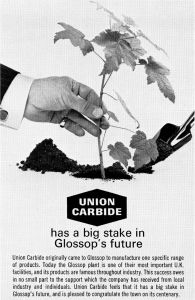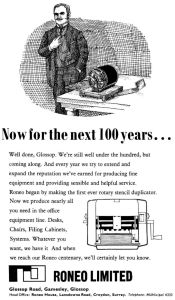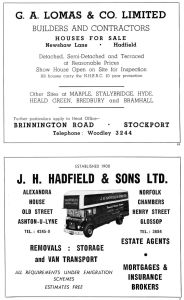 GLOSSOP CENTENARY HANDBOOK 1866 - 1966
GLOSSOP CENTENARY HANDBOOK 1866 - 1966 
 GLOSSOP CENTENARY HANDBOOK 1866 - 1966
GLOSSOP CENTENARY HANDBOOK 1866 - 1966 
 Ada Williams, Mayor 1966-67 |
 Burial urn of the Bronze Age and bone fragments found at Shire Hill by Alderman Hurst |
 John Wood's Mills about 1850, from Bank Street |
 Town hall original design. The dome on the right was never built. The present clock tower was added in 1897. |


 Street Plan of Glossop in 1866 |
 Annual Remembrance Service, Norfolk Square Gardens |
 Centre of Glossop in 1906 (Norfolk Square) |
 Combined populations of the townships of Glossop, Whitfield, Chunal, Simmondley, Padfield, Hadfield and Dinting 1801-1861 from census returns |
 Population of Glossop Municipal Borough 1861-1961 from census returns |






 The Howard Lion at the Station |







 "Partington Players rehearsing one of their 50 successful productions |
 Glossop Town Map Future Pattern (1981) |
 E.C.Allen, Borough Surveyor |
 A greenhouse in Howard Park |
 A colourful corner in Manor Park |
 Back Row, left to right — M. Ashton; A. Broadbent; R. Woolley; R. Browne; J. Godson; R. Harvey and E. Parkin (Trainer). Front Row, left to right — N. Lumb; J. Hadfield; R. Chappell (Capt.); R. Howorth; and R. Walker. Front — Michael Czochan (Mascot). |
 Glossop Cricket Club take the field |
 Back Row, left to right — A. Kinder, W. O. Brien, M. Waterhouse, J. Higgins, J. McKenny, V. Chipchase, E. Dewsnap, P. Wilson Front Row, left to right — S. Bennett, H. B. Lomas, R. Berny, A. Eyre, H. Waterhouse, J. C. Platt, D. L. Smith, G. Brindley. |
 Group of players from the Glossop Golf Club |
 Glossop Concert Orchestra |
 Glossop and District Choral Society, Samson, December 4 1962 |
 Glossop and District Choral Society at rehearsal, Dinting schoolroom |